
12.12.2022 by Dr. Ligia de Souza, Claire Strasser
Insights into the insides of Advent Calendars
The first advent calendar filled with chocolates was born in 1958. Since then, the store shelves are overflowing with calendars containing beauty products, tea bags, local beers, tiny books, small toys and other delicious, luxurious products that can be packed into 24 (25 if you are lucky!) randomly assorted mystery compartments…all well before December 1st. Yet, the Advent calendar filled with chocolates remains a classic. Pleasant anticipation in the weeks before Christmas, a chocolate with a different shape is hidden behind each door and is just waiting to be eaten.
Scarcely anybody will think about rheological properties of chocolate while they pop this Christmas confectionary into their mouth. Yet, the processing in pipe of melted chocolate, its mold filling and even the mouth feel of the consumer are closely related to its viscosity.
The figure below shows shear viscosity curves of different chocolate types from the same manufacturer: white, milk, hazelnut and dark. All these chocolates differ in their ingredients and in the concentration of each component. For instance, white chocolate contains no cocoa, while being the key ingredient of dark chocolate. Table 1 shows the main ingredients (in weight order) of the four chocolates measured.

Table 1. Order of weight of the main ingredients of the four tested chocolates
| White | Milk | Hazelnut | Dark |
Sugar | 1 | 1 | 1 | 1 |
Cocoa mass | --- | 3 | 4 | 2 |
Cocoa butter | 2 | 2 | 2 | 4 |
Skimmed milk powder | 3 | 4 | 5 | 3 |
Hazelnut mass | --- | 8 | 3 | --- |
Important flow properties are the yield StressStress is defined as a level of force applied on a sample with a well-defined cross section. (Stress = force/area). Samples having a circular or rectangular cross section can be compressed or stretched. Elastic materials like rubber can be stretched up to 5 to 10 times their original length.stress (defined as the minimum StressStress is defined as a level of force applied on a sample with a well-defined cross section. (Stress = force/area). Samples having a circular or rectangular cross section can be compressed or stretched. Elastic materials like rubber can be stretched up to 5 to 10 times their original length.stress that will induce flow) and shear viscosity at high shear rates. Table 2 summarizes the results of the Casson model* applied on the viscosity curves of these chocolates.
*Casson model: A well-known and largely applied rheological model for describing the Non-NewtonianA non-Newtonian fluid is one that exhibits a viscosity that varies as a function of the applied shear rate or shear stress.non-Newtonian flow behavior of fluids with a yield StressStress is defined as a level of force applied on a sample with a well-defined cross section. (Stress = force/area). Samples having a circular or rectangular cross section can be compressed or stretched. Elastic materials like rubber can be stretched up to 5 to 10 times their original length.stress
Table 2. Yield StressStress is defined as a level of force applied on a sample with a well-defined cross section. (Stress = force/area). Samples having a circular or rectangular cross section can be compressed or stretched. Elastic materials like rubber can be stretched up to 5 to 10 times their original length.stress and viscosity of the four chocolates, determined by the Casson model
Chocolate | [Pa] | Viscosity [Pa×s] | Correlation coefficient |
White | 8.81 | 3.08 | 0.9996 |
Milk | 9.48 | 1.44 | 0.9996 |
Hazelnut | 7.44 | 1.23 | 0.9997 |
Dark | 6.18 | 0.92 | 0.9996 |
Here, the Casson viscosity decreases with the cocoa amount. The dark chocolate has the smallest shear viscosity and yield StressStress is defined as a level of force applied on a sample with a well-defined cross section. (Stress = force/area). Samples having a circular or rectangular cross section can be compressed or stretched. Elastic materials like rubber can be stretched up to 5 to 10 times their original length.stress, therefore being the easiest one to process as it has the lowest resistance to flow. White chocolate exhibits the highest viscosity and will likely be the most difficult to process. The milk and hazelnut chocolates have similar rheological behaviors.
Please do not feel the pressure of the manufacturing details, we do it for you! J Just enjoy your deserved piece of chocolate. It will help you be patient until Christmas, even if you actually can't wait. ;-)
